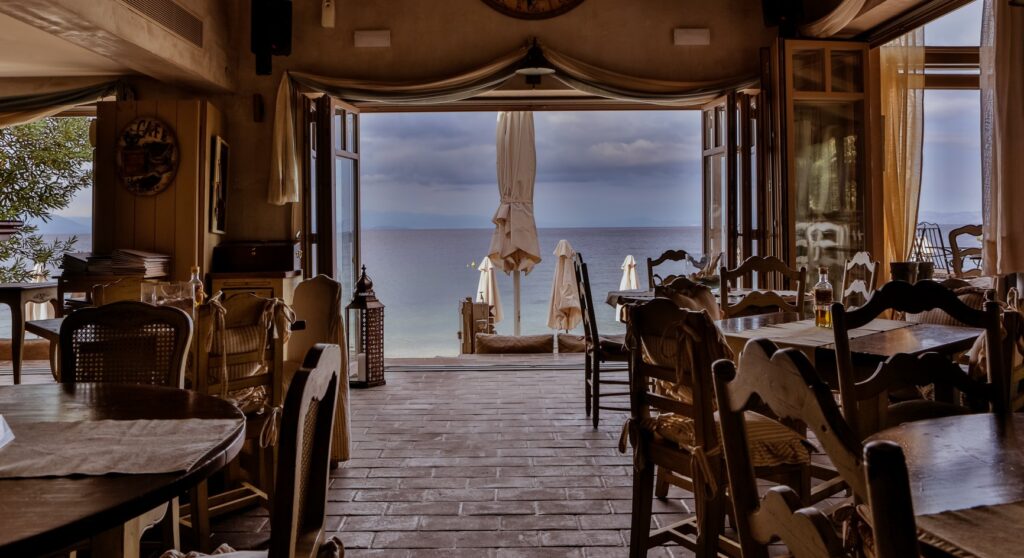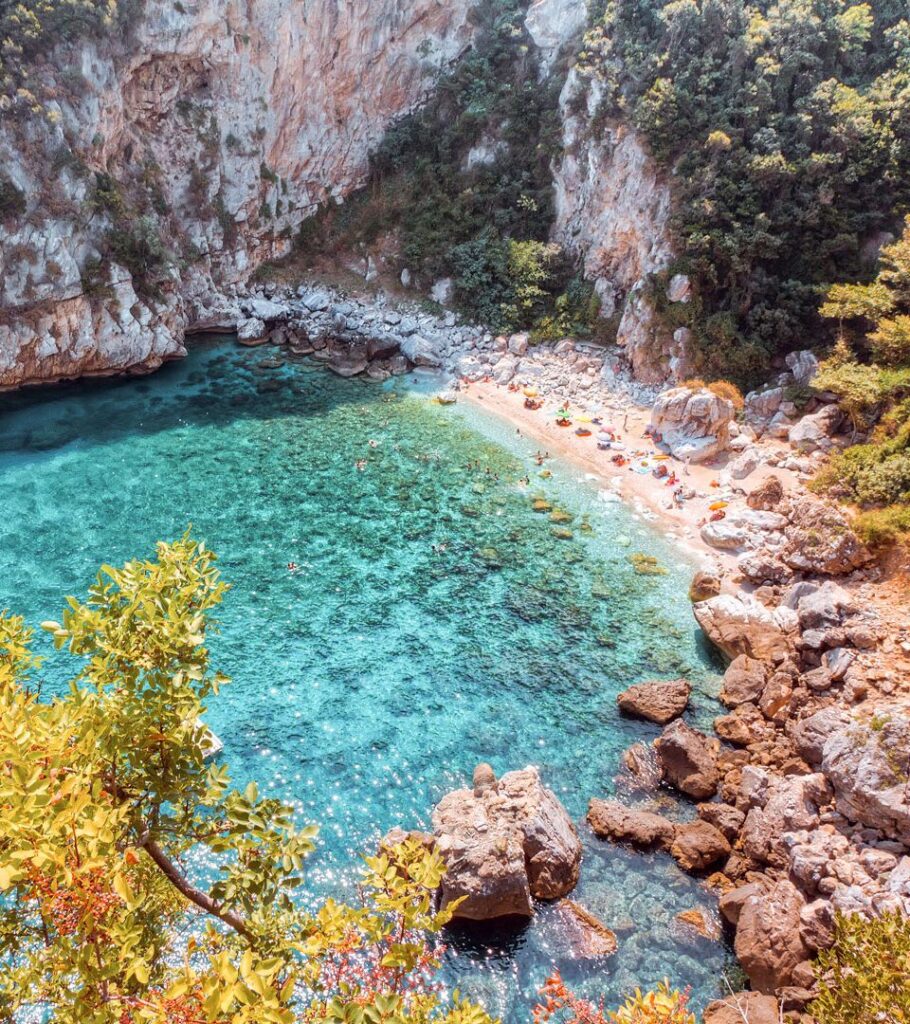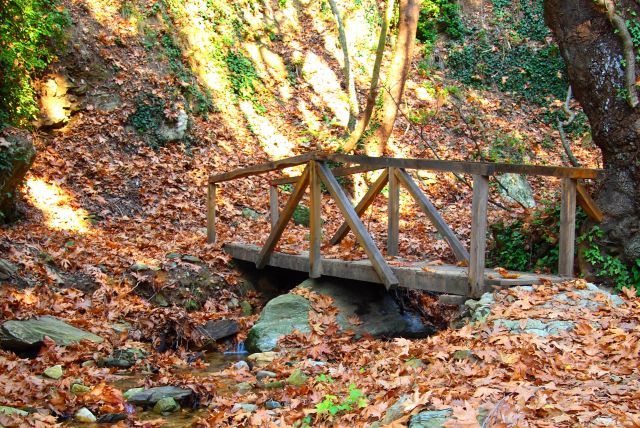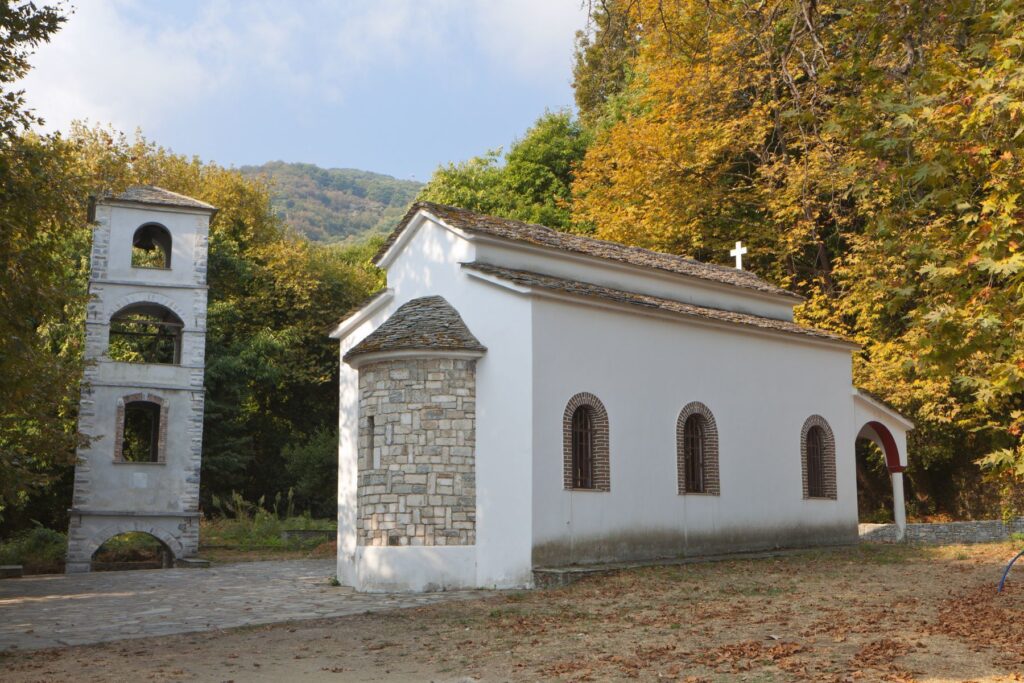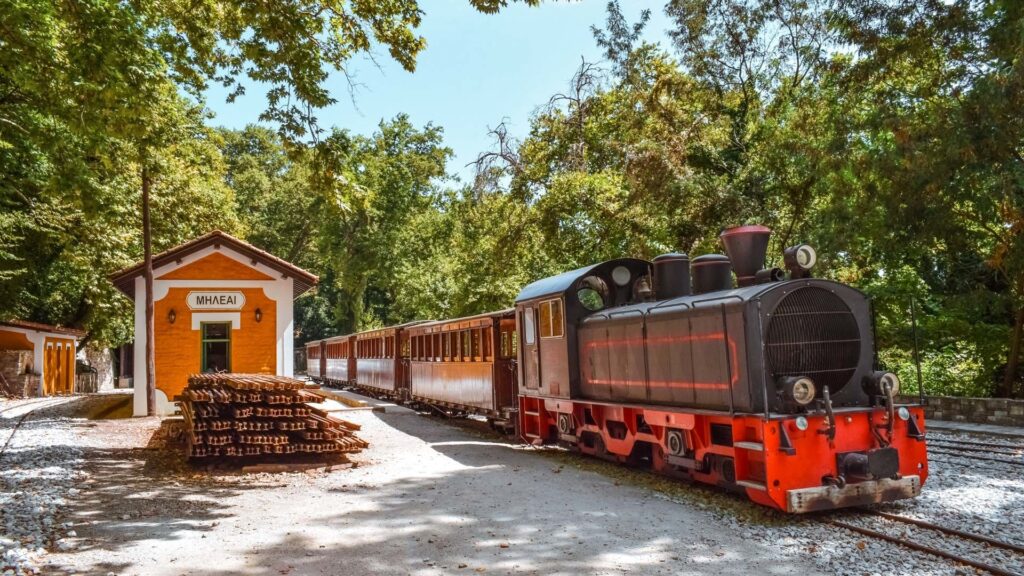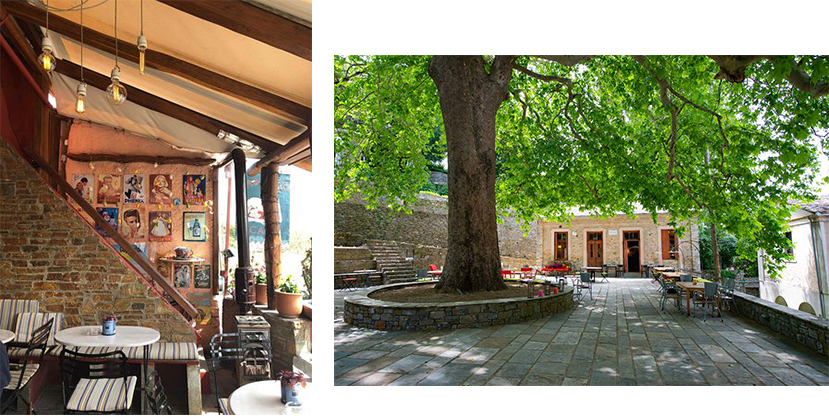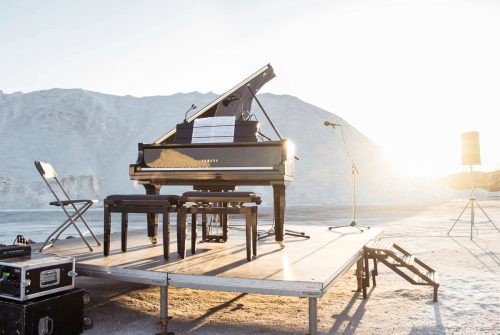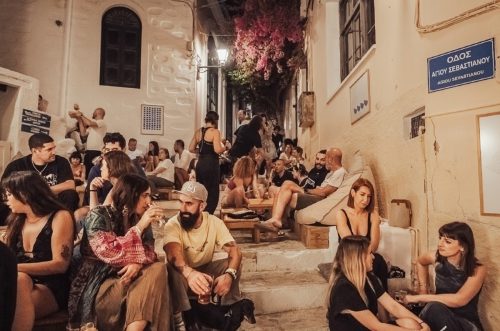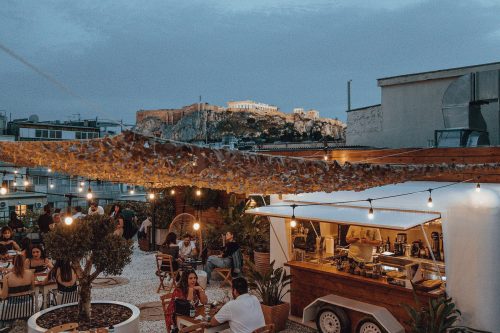Located almost directly between Athens and Thessaloniki, Pelion is a place that very few foreigners seem to know about. You’ll find very few crowds here and in some spots, locals-only- as this is by far one of Greece’s best-kept secrets.
You could drive around and see a lot of Pelion in one day, but if you have the chance we recommend you take your time and split your stay between the east and west and the mountains in the north, and explore as many of the charming villages as possible to get a feel of the local culture and traditions. Stroll through cobbled lanes and explore old stone mansions, tiny churches, and numerous water fountains; as you stop off and try enticing local products from small stores and taste authentic dishes at the taverns scattered around the village squares.
The whole region of the Pelion Peninsula is very lush and green, with so much nature to explore. There’s a wonderful mountain for hiking, gorgeous beaches to swim, and rocky cliffs that offer magnificent views of the region. And if you are a foodie, you can spend your entire time here eating your way around as you taste some of the most mouthwatering dishes.
How to get there
If you prefer to fly, the closest airport is Nea Anchialos Airport, about 30 km from Volos. Buses from Athens to Volos depart from Liossion KTEL Bus Station and it takes around 5 hours. From Thessaloniki, buses depart for Volos from Macedonia KTEL Bus Station and it’s a 3-hour trip. KTEL buses connect to various villages. If you have hired a car from Athens, you can drive via the National Highway Athens-Thessaloniki and it takes about 5 hours.
Getting around
In order to really explore the Pelion Peninsula, the best way is to have your own car. Public transport can not get you to all the places we mention below and with so much to see, you’ll definitely want to get around at your own pace.
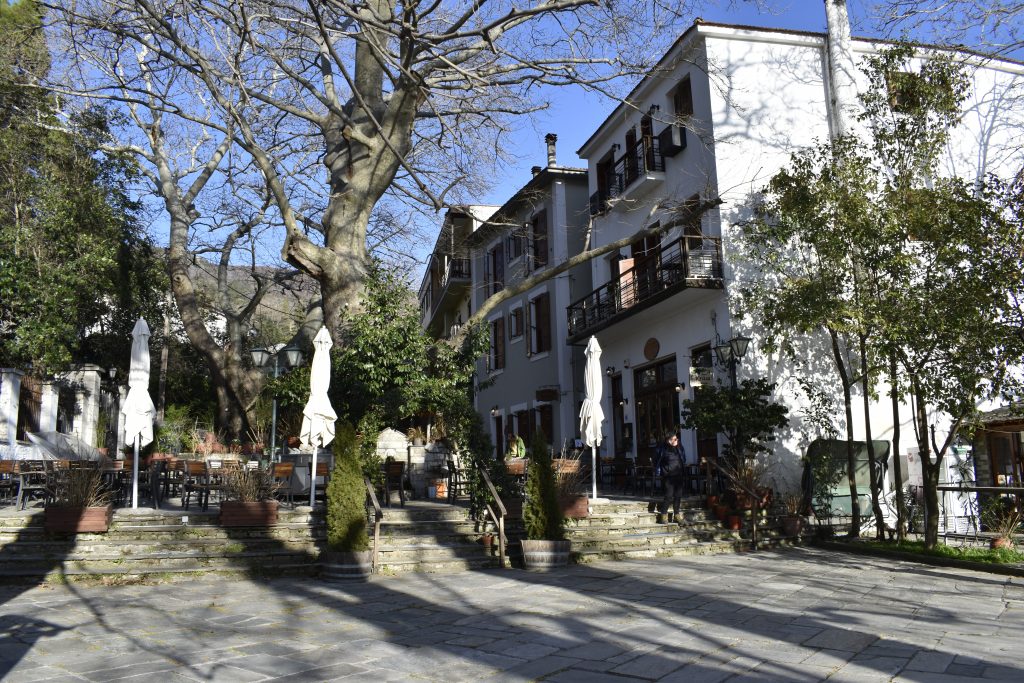
Best time to visit
Verdant and mountainous, and blessed with a beautiful coastline, the peninsula is wonderful for touring around and exploring- no matter what time of the year it is. In winter, when it snows, people come from Thessaloniki and Athens to ski down Mount Pelion. In summer, people from all over Greece come here to swim in the most crystal of clear water. It’s great in spring when the lush green is greener, the flowers are blooming and in the autumn, the colours of the forested mountain slopes are stunning and you can see an apple, walnut, and chestnut trees shed their fruits.
Things to do
-Take a ride on the legendary old steam train of Pelion (popularly known as Moutzouris). This train started working in the late 19th century and played a key role in the development of Pelion.
–Centaur’s Path in Portaria village is a hidden gem in Pelion, surrounded by splendid nature. The path is marked with red circles on stones, so as not to deviate from it. There is also a fountain with drinking water and some benches for visitors to rest before continuing their journey.
–Spring of Manas is found in Portaria, in a forest with dense vegetation, really close to Centaur’s Path. The unspoiled natural surroundings are breathtaking, and there are some lovely bridges that help you cross the small stream.
Museums
Greek School Museum is the name given to the old school where the famous freedom fighter (against the Turks), Rigas Valestinlis-Feraios attended. This building, also known as the School of Rigas, was also the school of other famous Greek personalities. Nearby, there is the Library of Zagora which has more than 15,000 old books and manuscripts.
The Museum of Folk Art and History of Pelion is housed in the Topali mansion, beneath the central square of Makrinitsa. The mansion was built in 1844 and looks like a fortress. It hosts items depicting folklife on Pelion.
The Museum of Worry Beads (Komboloi) is an appendix of the same museum in Nafplion. It presents the history and variety of worry beads, which is a huge part of Greek culture.
Spiritual sites
The historical Church of Agioi Taxiarches in the square of Milies was founded in the 17th century and was renovated in 1741. Inside, there are some unique frescoes with scenes from the Bible. Church of Agia Marina in the square of Kissos stands under tall plane trees and the Church of Panagia, established in 1767 is dedicated to the Assumption of the Virgin. It has interesting architecture and a tall bell tower, with bells from Odessa. The Byzantine Monastery of Agios Lavrentios was established in 1378 on the ruins of an older monastery. It played an important role in the Greek War of Independence and also deserves a visit.
Adventurous things to do
Mountain Climbing: soft slopes and easily accessed peaks make Mount Pelion a popular destination for hiking lovers and weekend mountain climbers. Two mountain shelters, one at Agriolefkes and the other at Agios Georgios of Zagora are very popular amongst locals.
Skiing: In Agriolefkes, near Hania, there is also a great resort for skiing lovers.
Mountain biking: with an abundance of mountain routes and trails this area is ideal for mountain biking.
Canyoning: this is one of the most popular activities available here as you can explore unknown lakes and ravines.
Cycling: bike along many of the area’s winding roads, which offer striking views of the sea below.
Kayaking: enjoy a sea kayaking trip along the coast. The scenery is gorgeous, especially going along the crystal clear water.
Sailing: the closest island to the Pelion Peninsula is Skiathos, which you can reach from the port of Volos. The waters around this island are an amazing place to go sailing.
Hiking: most of the trails link old villages and will lead you past beaches, along abandoned railways. The best hiking is around Mount Pelion in the northern part of the peninsula.
Must visit traditional villages of Pelion
Portaria is one of the most modern villages of Pelion, located at the foot of Mount Pelion, it’s the first village you come across when driving from Volos. Here you will find a range of luxurious hotels, restaurants, tavernas, cafes, bars, and shops.
Zagora is situated on the eastern slopes of Mount Pelion, with a great view of the Aegean. Zagora has four districts, all meeting around the central square of Agios Georgios, having taken its name after the adjacent small church. Here you will find the famous 18th Century Public Library, which nowadays operates as a lending library with many and great, rare books.
Vyzitsa boasts stone-paved alleys, mansions, lush greenery, and stone fountains. Climb up its central cobblestones alley heading for the central square or walk around the picturesque neighbourhood of Argyraiika, and go hiking to Milies or to the coastal village of Kala Nera.
Makrinitsa is known for offering one of the best panoramic views to Volos and the stunning Pagasetic Gulf has retained the traditional Pelian architecture and construction. Its lovely stone-paved alleys, enchanting fountains, and lovely plants, all make Makrinitsa one of the most breathtaking destinations of Pelion. There are also unique art cafes and galleries run by talented local artisans displaying their beautiful creations.
Pinakates is a remote village that boasts majestic views; its small central square sheltered under a big plane tree combined with its authentic scenery lures locals and visitors alike.
Tsagkarada lies 500m above sea level on the eastern side of Mount Pelion, along a densely
wooded area, looking out to the Aegean. Here, you feel close to nature with an abundance of chestnut and plane trees. Sit and have a coffee at the central square of Agia Paraskevi, where the great Plane Tree, which is ten centuries years old is the main feature. If you are here during November, make sure you visit the Chestnut Festival, where you can enjoy grilled chestnuts as well as other local delicacies, plus traditional music and dance.
In Milies, you can visit the craft museum and the library, and make sure to have lunch in the taverna at the old railway station.
Beaches of Pelion
On the eastern side of the Pelion peninsula, there are some gorgeous beaches with mesmerizing waters. Mylopotamos, Fakistra, and Agios Ioannis are some of the most popular beaches here. Also check out Chorefto, Potistika, and Damouchari- they are just as striking as each other.
Don’t leave until you…
-Experience a day trip around the Pelion Peninsula to visit the Sea Caves of Thetis. You’ll leave from either the port of Chorefto or Agios Ioannis. From there, head north and discover an uninhabited and truly unspoiled coastline as you explore the stunning sea caves with your guide and even have the chance to swim and snorkel in some of them along the way.
-Stop by a welcoming little women’s cooperative in Vyzitsa where a wonderful selection of seasonal jams, marmalade, spoon sweets, and other products are produced. You can sample many of the products and support the Women’s Agritourism Cooperative in Vyzitsa. Visitors can buy all the handmade products, while also watching how they’re made.
-Attend a cooking school such as Kritsa in Portaria. You can learn how to make local dishes based on organic farm produce (which also supplies the restaurant). Pick your ingredients before making spetzofai (Pelion’s famous casserole of local sausage, green peppers, and grated tomatoes).
-Buy some local herbs and spices from Myrro in Portaria. Try the teas, herbs, and spices – sourced from Pelion, and other small Greek suppliers from the rest of Greece.
-Visit Karaiskos Farm an organic farm that produces lots of fresh fruits and vegetables,
such as potatoes, tomatoes, cucumbers, zucchinis, eggplants, pumpkins, peppers, radishes, and more. They also keep chickens and produce their own eggs. You’ll learn how to use fresh food to make tasty regional dishes and family recipes during your class on the farm.
Where to eat
Starting off casual, try the best bakery in Pelion- Korbas, Milies –and taste the delicious eliopsomo (olive bread). Run by the same family for three generations the bakery is famous for its cheese bread, biscuits, pies, and homemade pasta.
El Resto-Bar: Located in the Agapitos Villas this is a cozy spot serving up a variety of modern dishes and Greek-inspired cocktails and authentic spirits (Tsipouro being the main one).
Taverna Paradisos: This traditional Greek tavern right on the sea offers a range of local dishes including meat and seafood.
Anapodo Platani: A creative and modern restaurant, this is the place to go if you want to try some Modern Greek cuisine.
Dipnosofistis Restaurant Bar: Has been operating since 1992 on the old road that leads to Mylopotamos beach, at a beautiful estate covered with fruit trees and plants.
Kardamo: With wonderfully rustic decor, this tavern is nicely situated on the hillside of Markinitsa, with splendid views way down from the mountains to the seaside of Volos.
Taverna Meintani: The locals refer to this taverna as Niki’s (name of the owner) who has been cooking here for over two decades. Eating at Niki’s is like being invited into her cozy home; she grows all of her fruit and vegetables, before baking, stewing, or preserving them in sugar syrup.
Apolafsi, Makrinitsa: head here for the best restaurant with a view!
Aggelika, Mylopotamo: this is one of the best fish restaurants in Pelion. Set above the turquoise waters of Mylopotamos beach, this restaurant was set up by a fisherman and named after his daughter- needless to say, the fresh catch of the day is a must-try!
Six Keys, Afyssos: This is a high-end modern Greek restaurant that offers fine wining and dining. Dishes here, devised by Greece’s superchef Ioannis Baxevanis, showcase unique local ingredients while providing creative twists on traditional Greek favourites.
Local delicacies & dishes
Many authentic Greek products can be found in Pelion, including extra virgin olive oil, local house wine, vinegar, golden thyme honey, fruit liqueurs, a wonderful variety of herbs and teas, and many sweets and jams. Pelion is also famous for its chestnuts, hazelnuts, and walnuts.
The most famous fruit of Pelion is fyriki, a type of small apple that is largely cultivated in the traditional villages of the area and they turn it into a nice spoon sweet.
The traditional specialties of Pelion include a white bean soup called Fasolada, cheese-bread called Tyropsomo, olive bread- Eliopsomo, high-quality meat as many locals are involved with cattle breeding and Spetsofai, a spicy dish with peppers and sausage cooked in tomato sauce. Also try the Kapamá roast stuffed lamb with greens, rice, and herbs, oven cooked for 3-4 hours. Also try the Boubári roasted sausage – stuffed mutton sausage with rice, minced meat, greens, and herbs, oven cooked with potatoes; and Anthákia – Zucchini blossoms, stuffed with rice and herbs, cooked in a casserole or fried with cheese stuffing. And for a vegan delight, Tsitsiravla is a vegetable dish of pickled tender leaves.
To drink
Anna na Ena Milo, Milies, with its art-plastered walls, single-origin coffee, and sixties music is a cool spot to grab a Frappe. Try the homemade cakes and pies and sit in the glass-roofed verandah for a spot of people-watching. Also check out: Cafes Mirtillos, Agna Di Cafe DiVino, Art Cafe Makrinitsa, Ylien, Aeriko, and Antico.
For some great wine, head to Milea Winery and Anapodo Platani Wine Bar. The magnificent building is an old café of the traditional architectural style of Pelion, which has been converted into an elegant yet homely wine bar with vintage chandeliers and wooden handmade marble top tables.
Where to stay
Kritsa Gastronomy Hotel: If food is one of the main reasons for coming to the Pelion Peninsula (and it should be), then consider staying right on Karaiskos Farm at the Kritsa Gastronomy Hotel. Just like the farm itself, the hotel is family-run and sustainably operated, and the majority of its delicious food comes right from the organic farm next door.
Sunrise Tsagkarada: The hotel is locally run in a sustainable building, and it uses all kinds of eco-friendly products during day-to-day operations. The hotel is also beautifully designed and has a fantastic pool with incredible views.
For some more boutique hotels check out Archontiko Sakali, Amanita, Lotus Tree, and The Old Silk Store.
At Agios Lavrentiοs, Magnesia, a 19th-century oil mill has turned into a luxurious guesthouse, keeping all the traditional elements of the original stone building. “Palio Eleotrivio” is located next to a small river. Its large rooms are characterized by the warmth of combining wood and stone and the great care the owner showed in equipping them.
Anovolios Boutique Hotel is found in the beautiful village of Agios Georgios Nilias, in Pelion, and has a unique view of Pagasitic Bay, Evia Island, the Sporades islands, and surrounding mountains.

